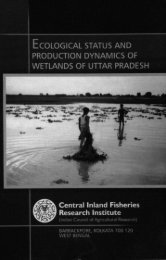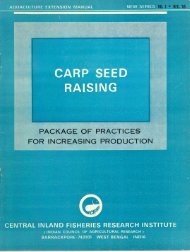View - Central Inland Fisheries Research Institute
View - Central Inland Fisheries Research Institute
View - Central Inland Fisheries Research Institute
- No tags were found...
You also want an ePaper? Increase the reach of your titles
YUMPU automatically turns print PDFs into web optimized ePapers that Google loves.
20Local name: Mahasol, MahseerConservationStatus: Near Threatened.Identifying features: Mouth small, lips thick, fleshy with the labial fold continuous;lower lip with an uninterrupted posterior groove forming a median 10be.Barbels2 pairs (maxillary barbels equal to eye-diameter, rostral pair shorter).A scalysheath at base of dorsal fin, dorsal spine bony, smooth. Scales large, lateral linewith 22 to 27 scales.General information: Inhabit rivers and lakes, also in rapid streams with rockybottom. Grow better in a river with a rocky bottom. Travel toward headwatersat the start of the rainy season and downstream at the end of the rainy season.Omnivorous, feed on filamentous algae, chironomid larvae, water beetles andcrustaceans. Spawn from March to September, over stones and gravel. Reportedto reach 150 em TL, and gain a maximum weight of 68 kg by Thomas, 1897.Considered a long-living species. Maximum size: 150 em.<strong>Fisheries</strong>: Important food and a prized game fish.Family: Cobitidae• Pectoral fin with an unbranched (simple) ray• Barbels 3 or 4 pairs• Erectile spine present near eye28. Lepidocephalus guntea (Hamilton-Buchanan)Local name: Guntea loach, GutumConservation Status: Not EvaluatedIdentifying features: Mouth inferior. Barbels 3 pairs. Short dorsal fin insertedposterior to origin of pelvic fins., and nearer to caudal base than to snout tip.Dorsal fin with 8 to 10 rays (6 to 7 branched).Caudal fin truncated. Scales small,













